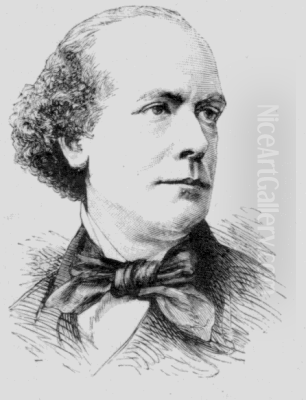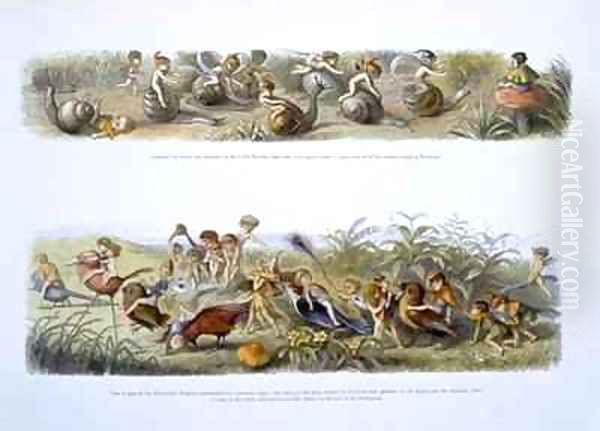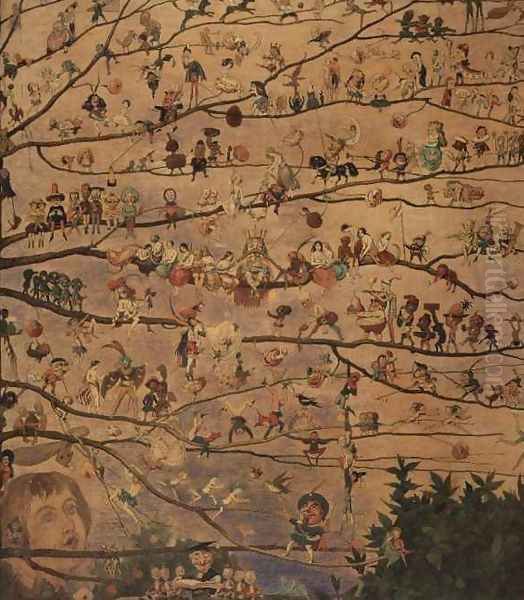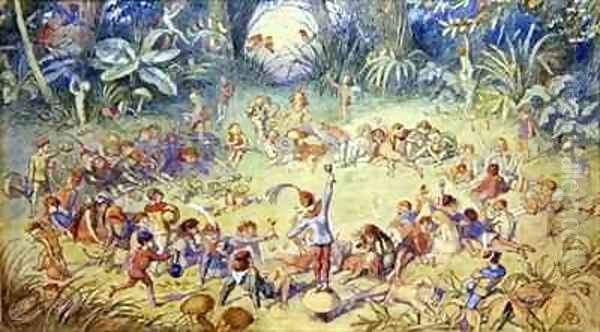
Richard Doyle stands as a pivotal figure in the rich tapestry of Victorian art. Born in London on September 18, 1824, and passing away in the same city on December 11, 1883, Doyle carved a unique niche for himself as an illustrator, watercolourist, and cartoonist. His work, brimming with wit, whimsy, and keen observation, captured the imagination of his contemporaries and continues to enchant audiences today. He navigated the burgeoning world of illustrated journalism and book publishing, leaving an indelible mark through his distinctive style and imaginative creations, particularly his enchanting depictions of fairyland.
An Artistic Upbringing
Richard Doyle, affectionately known as "Dickie," was born into an environment steeped in art. His father was the celebrated Irish political caricaturist John Doyle (1797-1868), famous under the pseudonym "HB." John Doyle's satirical prints were highly influential, known for their cleverness and lack of malice, qualities that Richard would inherit and adapt in his own work. The Doyle household in London was a hub of creativity, with Richard and his siblings, including James William Edmund Doyle (an antiquarian and artist) and Henry Edward Doyle (who later became director of the National Gallery of Ireland), encouraged from a young age to draw and observe the world around them.
Unlike many artists of his time, Richard Doyle received little formal art training. His education was largely conducted at home, under the guidance of his father and through his own prodigious efforts. His innate talent was evident early on. At the tender age of twelve, he produced a charming series of drawings titled Home for the Holidays. By fifteen, he had created a remarkable illustrated manuscript journal detailing the Eglinton Tournament of 1839, a medieval-style jousting event. This work, showcasing his already developed skills in composition and humorous characterisation, is now preserved in the British Museum.

Another significant early work was his personal journal kept around the age of sixteen (published posthumously in 1885 as A Journal Kept by Richard Doyle in the Year 1840). Filled with lively sketches, caricatures of family and friends, and witty observations on London life, the theatre, and art exhibitions, it reveals a young artist already possessing a sharp eye, a playful imagination, and remarkable facility with the pen. This early immersion in drawing and narrative laid the foundation for his future career.
The Punch Years and Rising Fame
In 1843, at the age of just nineteen, Richard Doyle began contributing to Punch, the satirical magazine that had been founded only two years earlier. Punch was rapidly becoming a British institution, a powerful shaper of public opinion and taste, featuring work by leading writers and artists. Doyle's talent was quickly recognised, and he soon became one of the magazine's star illustrators, joining the ranks of artists like John Leech, a master of social comedy, and later, John Tenniel, who would famously illustrate Alice's Adventures in Wonderland.
Doyle's contributions to Punch were varied and highly popular. He produced numerous social cartoons, initial letters, decorative borders, and illustrations for articles. His series "Manners and Customs of Ye Englyshe" offered a humorous, panoramic view of Victorian society, gently poking fun at everything from parliamentary debates to crowded balls and seaside holidays. His style was perfectly suited to the magazine's tone – observant, witty, and generally good-natured, though he could also produce effective political satire when required, such as his 1848 cartoon "The Great Sea Serpent," depicting revolutionary turmoil sweeping across Europe.
Perhaps his most enduring contribution to Punch was his design for the magazine's cover. Introduced in January 1849, Doyle's iconic design featured Mr. Punch himself, surrounded by a whimsical array of frolicking figures, animals, and mythical creatures, including fairies and elves – a clear foreshadowing of his later specialisation. This cover, with minor modifications, graced the magazine for over a century, becoming instantly recognisable worldwide and cementing Doyle's association with the publication. His work for Punch established his reputation and made him a household name.
Principle and Departure: Leaving Punch
Despite his success, Doyle's tenure at Punch came to an abrupt end in 1850. The reason was a matter of deeply held religious principle. Doyle was a devout Roman Catholic, a faith inherited from his Irish father. In 1850, Pope Pius IX re-established the Roman Catholic hierarchy of bishops in England, a move that provoked a wave of anti-Catholic sentiment, often referred to as the "Papal Aggression" controversy.

Punch magazine joined vehemently in the anti-Catholic outcry, publishing cartoons and articles that Doyle found offensive and disrespectful towards his faith and the Pope. John Leech's cartoons were particularly pointed. Unable to reconcile his conscience with the magazine's editorial stance, Doyle felt compelled to resign his position. This was a significant and potentially damaging career move, sacrificing a prestigious and lucrative post for his beliefs. His friend and fellow contributor, the novelist William Makepeace Thackeray, reportedly lamented his departure. This act of principle, however, marked a turning point, pushing Doyle towards other avenues, particularly book illustration and watercolour painting.
Illustrating the Literary Giants: Thackeray and Dickens
Freed from the weekly demands of Punch, Richard Doyle focused increasingly on book illustration, collaborating with some of the greatest writers of the Victorian age. His association with William Makepeace Thackeray was particularly fruitful. Thackeray, who was also an accomplished draughtsman himself, admired Doyle's light touch and social observation. Doyle provided memorable illustrations for several of Thackeray's works.
Most notably, he illustrated Thackeray's sprawling novel The Newcomes (serialised 1853-1855). His drawings captured the novel's blend of social satire, sentiment, and sprawling cast of characters, complementing Thackeray's narrative style. He also illustrated Thackeray's humorous historical burlesque Rebecca and Rowena (1850) and the delightful Christmas fantasy The Rose and the Ring (1855), where his whimsical style found perfect expression.
Doyle also contributed illustrations to the Christmas Books of Charles Dickens, another titan of Victorian literature. While Dickens's primary illustrators included artists like George Cruikshank and Hablot Knight Browne (known as "Phiz"), Doyle was commissioned for The Chimes (1844), The Cricket on the Hearth (1845), and The Battle of Life (1846). His style, often more delicate and less grotesque than that of Cruikshank or Phiz, offered a different visual interpretation of Dickens's world, particularly excelling in scenes requiring charm or fantasy elements.
Ruskin and the Golden River
Another significant literary collaboration was with the influential art critic and writer John Ruskin. Doyle provided the illustrations for Ruskin's only work of fiction, the fairy tale The King of the Golden River (published 1851, though written earlier). This story, set in the Alpine region of Styria, tells the tale of three brothers and the magical Southwest Wind, Esquire.
Doyle's illustrations perfectly captured the story's blend of morality, fantasy, and dramatic landscape. His depictions of the grotesque, miserly elder brothers contrasted beautifully with the gentle hero, Gluck, and the majestic, elemental personification of the wind and river. The collaboration was a natural fit, as Ruskin championed art that was true to nature yet capable of conveying deeper moral and spiritual truths, while Doyle excelled at bringing imaginative worlds to life with convincing detail and charm. Ruskin, himself a skilled draughtsman influenced by artists like J.M.W. Turner, appreciated Doyle's artistry.
The Enchanted Realm: Doyle's Fairyland

While his contributions to Punch and his book illustrations secured his fame, Richard Doyle is perhaps most beloved for his depictions of fairies and the supernatural. The Victorian era had a profound fascination with folklore, myth, and the unseen world, and Doyle became one of its foremost visual interpreters. His fairies were not the ethereal, wispy spirits of some traditions, but rather mischievous, lively, and often comical little beings, integrated seamlessly into natural landscapes.
His masterpiece in this genre is undoubtedly In Fairyland: A Series of Pictures from the Elf-World (1870). This lavishly produced book featured sixteen large colour plates engraved and printed by the renowned Edmund Evans, accompanied by a poem written by William Allingham. Doyle's illustrations depict a vibrant, bustling world of elves, goblins, and sprites engaged in various activities: riding on snails, battling wasps, attending fairy royalty, and revelling amongst flowers and fungi.
The In Fairyland plates showcase Doyle's mature style at its best. The compositions are intricate and teeming with detail, inviting viewers to explore every corner. His linework is fluid and expressive, and the colours, expertly printed by Evans (who also printed works for Randolph Caldecott and Kate Greenaway), are rich and harmonious. These images defined a particular vision of fairyland – playful, slightly chaotic, and deeply rooted in the natural world – that proved immensely popular and influential, inspiring later artists like Arthur Rackham.
Artistic Style: Line, Wit, and Observation
Richard Doyle's artistic style is instantly recognisable. Central to it is his mastery of line. His penmanship is fluid, energetic, and seemingly effortless, capable of capturing movement, character, and intricate detail with remarkable economy. Whether sketching a crowded ballroom scene for Punch or delineating the delicate wings of a fairy, his line is always alive and expressive.
Humour was a constant element in his work, ranging from gentle satire of social customs to outright slapstick in works like The Foreign Tour of Messrs. Brown, Jones and Robinson (1854), which chronicled the misadventures of three hapless English tourists on the Continent. This humour was based on keen observation of human nature, fashion, and social interactions. He had an exceptional ability to capture characteristic poses and expressions, often populating his scenes with a multitude of distinct individuals.
While primarily known for his pen-and-ink work, Doyle was also a skilled watercolourist. In his later career, he devoted more time to watercolour painting, often depicting landscapes inspired by trips to Scotland, Wales, and Ireland, as well as historical and fantasy subjects. These works often possess a softer, more atmospheric quality than his illustrations, showcasing his sensitivity to colour and light. His watercolour style sometimes echoes the work of contemporaries like Myles Birket Foster, known for idyllic rural scenes, but Doyle always retained his unique touch of whimsy.
Later Life and Continued Creativity
After leaving Punch and establishing himself as a leading book illustrator, Doyle continued to work steadily, though perhaps less prolifically than in his youth. He remained a popular figure in London's artistic and literary circles, known for his charm and integrity. He exhibited his watercolours regularly, including at the prestigious Grosvenor Gallery.
His Catholic faith remained central to his life and sometimes informed his art, particularly in later years when he occasionally tackled religious themes. However, his primary focus remained on the realms of fantasy, social observation, and landscape. He never lost his imaginative spark or his delight in the whimsical and the picturesque.
His family connections remained important. His nephew, Arthur Conan Doyle, son of his brother Charles Altamont Doyle (also an artist, though troubled), would achieve worldwide fame as the creator of Sherlock Holmes. Conan Doyle retained fond memories of his talented uncle and even wrote a poem commemorating one of Richard's fairy pictures. The artistic legacy of the Doyle family, originating with John Doyle's sharp political commentary, branched out through Richard's unique blend of humour and fantasy.
Contemporaries and Context
Richard Doyle worked during a vibrant and transformative period in British art. The era saw the decline of the great Romantic painters like Turner and Constable and the rise of new movements. The Pre-Raphaelite Brotherhood, founded in 1848 by artists like John Everett Millais, Dante Gabriel Rossetti, and William Holman Hunt, challenged academic conventions with their emphasis on detail, bright colour, and serious subjects, often drawn from literature and religion. While Doyle's style differed significantly from the intense realism of the Pre-Raphaelites, he shared their interest in narrative and detailed observation.
The Victorian era was also a golden age for illustration, fueled by advances in printing technology (especially wood engraving, perfected by firms like the Dalziel Brothers) and the growth of the publishing industry. Illustrated magazines like Punch and The Illustrated London News flourished, and illustrated books became increasingly popular. Doyle was a key figure in this movement, alongside contemporaries like John Leech, John Tenniel, George Cruikshank (an earlier master of caricature and illustration), and later figures like Randolph Caldecott and Kate Greenaway, who revolutionized children's book illustration. His work stands out for its unique combination of elegance, humour, and imaginative fantasy. He navigated a path distinct from the biting satire of earlier caricaturists like James Gillray or Thomas Rowlandson, favouring a gentler, though still perceptive, wit.
Legacy and Influence
Richard Doyle died suddenly from apoplexy on December 11, 1883, at the age of 59. He left behind a substantial body of work that continues to be admired for its artistic skill, imaginative power, and historical significance. His contributions to Punch, particularly his iconic cover design, helped define the visual identity of one of Britain's most enduring publications.
His book illustrations brought the works of Thackeray, Dickens, and Ruskin to life for countless readers, shaping their visual understanding of these literary classics. His greatest legacy, however, arguably lies in his depictions of fairyland. Works like In Fairyland established a visual language for the fairy world that influenced generations of illustrators and captured the Victorian imagination. Artists like Arthur Rackham and, in their own way, perhaps even Beatrix Potter, owe a debt to Doyle's pioneering exploration of whimsical fantasy rooted in careful observation of nature.
His work is preserved in major collections, including the British Museum and the Victoria and Albert Museum in London. Richard Doyle remains a cherished figure in British art history – an artist whose technical facility was matched by his boundless imagination and gentle humour, creating worlds both real and fantastical that continue to delight and inspire. He was a master draughtsman, a keen observer of his times, and the undisputed king of Victorian fairyland illustration.